
At some point, just about everyone manages to mess up their precious electronics. In this case, someone (not me) somehow managed to totally demolish the mini USB port in their new Motorola cell phone. Surface mount repairs can be challenging without some serious tools, but it’s possible to replace parts without a re-work station. (Guess what I’m getting for Christmas this year.) Today I’ll show you that’s it’s possible to repair a surface mount part with some fairly inexpensive tools.
To do this repair, you’ll need just a few tools:
- fine tip soldering iron (Weller 15 watt)
- Dremel tool with cut off wheel
- De-soldering Braid
- Torx T5 screwdriver
- small flat bladed screwdriver (optional)
- Diagonal cutters
- small hemostat or fine tweezers
- Panavise, helping hands or similar bench top holding device.
I already had all the soldering gear, but I had to track down a new T5 driver since mine vanished. I picked up a decent quality, iron oxide coated T5 driver at Sears for a little over $3. Sears actually has these individually, so you don’t need to buy a set.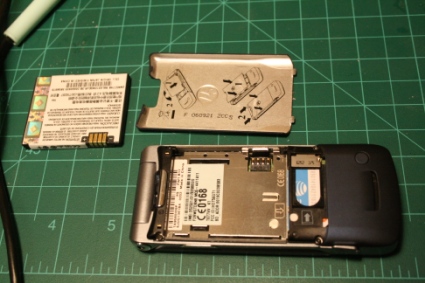
To get started, take off the back cover and remove the battery.
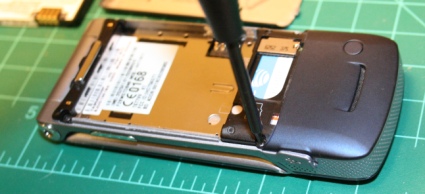
Next, whip out that Torx T5 and remove the screws holding the phone together. On this one, there were only four to remove.

With the screws out, gently pull the phone apart. The lower half of this Motorola clips together, so I gently worked around the edges with a small flat screwdriver until it came apart.

The SIM card board easily separates from the phone via the flat SMD connector. Just gently apply pressure near the connector and it comes right off.
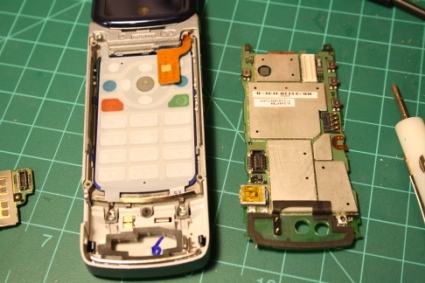
Next, the flat ribbon cable needs to be detached in the same manner, and the main PC board removed from the phone. It should pull right out once the cable is disconnected.
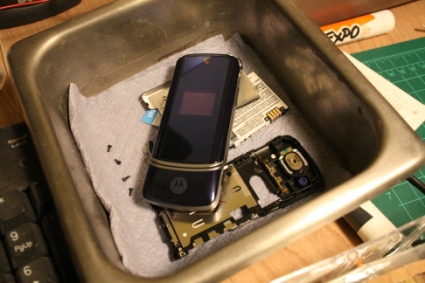
As you disassemble the phone, put each of the pieces into a parts bin. Any sort of container will do, but I’d avoid a static generating plastic Tupperware container.

Carefully place the board in your clamp/Panavise/whatever – I had to line up the buttons with the slots in the vise, or I probably would have damaged them when I clamped the board.
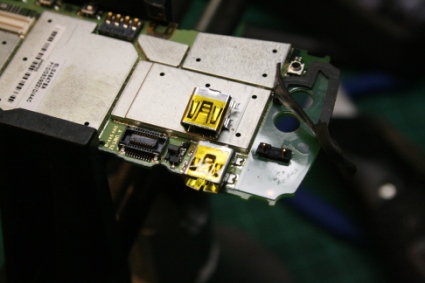
You’ll need a new connector before you can fix anything. I ordered this new SMD mini USB port from Mouser electronics (Part #538-67503-1020). It’s very nearly the exact same part, down to the yellow tape on top.
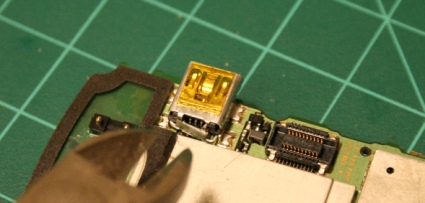
In order to check the condition of the pins, clip the two tabs that hold the rear shielding on to the connector with a pair of diagonal cutters (optionally, you can use a Dremel/rotary tool).

With the rear shield removed, we can access the rear pins – Unlike the front, everything looks pretty good. The advantage of surface mount parts is that they don’t require much solder to hold together. Unfortunately, when you’re replacing a surface mount part, a small amount of solder can keep you from removing the part without damaging the board.
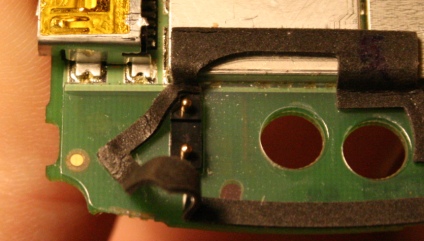
To keep from burning this foam seal, peel it back and stick it off to the side.
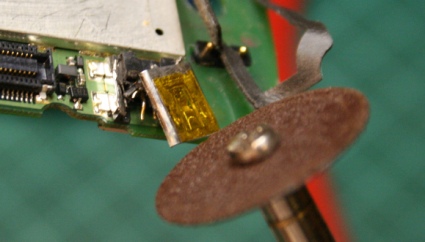
Enter the rotary tool. Sliced the top off of the connector by cutting the sides lengthwise.
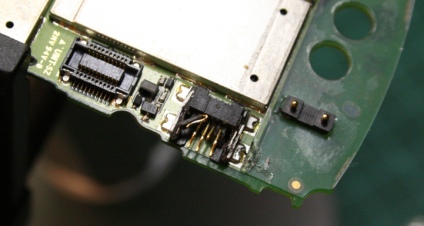
The damage to the pins was pretty amazing once the top was off. Ouch! I went ahead and peeled off that foam seal when I started cutting. Note that the fourth pin is actually shoved inward and upward just a bit.
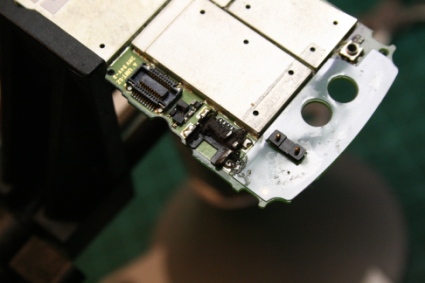
Next, cut across the center of the connector. The bent pins should be gently cut loose and the upper half of the plastic connector will probably fall apart. The shielding on the sides should be cut to allow each leg to be removed individually. (Be careful not to cut the PC board below!)
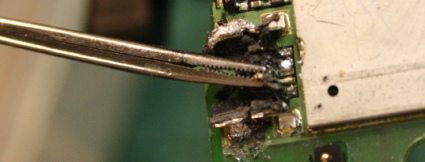
Working from one side to the other, heat up the solder pad on each pin. Then use some tweezers to grip each pin of the connector. (I used a small pair of alligator forceps) If the solder is hot enough, the surface mount pin should come loose with little to no force. It’s vitally important to be as gentle as possible with each one. The solder pads on the PC board are very delicate, and easy to pull up if you’re not careful. Unfortunately, overheating the pads can also cause them to pull up. So be quick about it!
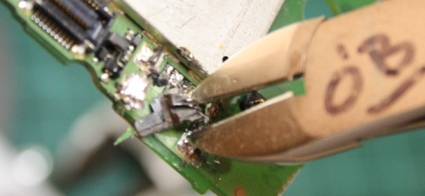
With the delicate pins out of the way, I carefully cut apart the remaining plastic and removed it.
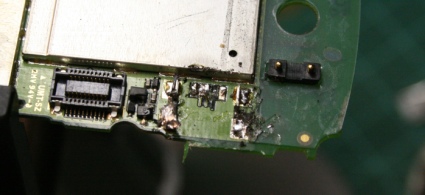
Finally, the remaining legs of the shielding were heated and removed from the board.

After that, I used de-soldering braid to remove the excess solder from the pads. Not everything came out perfectly. The second to last pad didn’t make it through the removal process. In this case, I’m pretty sure that that pin took some impact when the connector was trashed. I was careful not to torque the pins as I removed them, but I’m not surprised that one pad didn’t make it considering the amazing amount of damage to the port.

The pin in question is numbered X on this Motorola charger pin-out. It’s shorted with a resistor to pin 2 to indicate that a charger is connected. Unfortunately, the phone will never charge from a wall charger again (unless the board is swapped out.) It’s possible that the trace could be rebuilt with a conductive pen, but I’m doubtful that it would be that successful.

Now we’re ready for the new port. There’s one difference between the original and the replacement: two pins that are designed to align the port on the board. They’re plastic, so it’s an easy fix.

Grind them off with your ro
tary tool so that the connector is smooth on the bottom. After that, clip the tabs on the new port and remove the rear shielding as before.
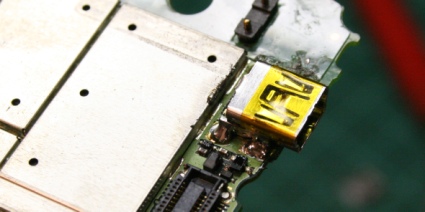
After the new port is aligned (double check the pins in the rear!) solder one of the shielding legs to the board. Double check the pin alignment again, and solder the other legs. Now the port should be solidly mounted.
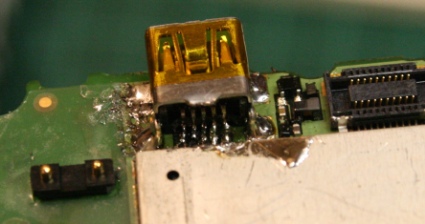
Next, the pins on the new port need to be soldered. The super fine tip on my 15 watt Weller pencil made this easy. Alternatively, you can use a wider tip to solder things and go back over the pins with de-soldering braid to remove any solder bridges. If you forgot to remove the rear shield, you’ll have one hell of a time soldering the pins. On this particular phone, the metal shielding behind the port made it impossible to access the pins without removing the rear shielding.
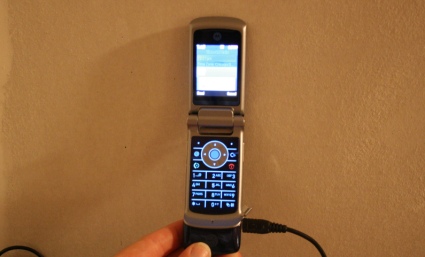
Despite the missing pin, the phone started up just fine when we plugged it in. One more cell phone saved from the recycle bin.















If you got the port on a piece of “flex” then you can do like this and change the whole thing, takes 10 min and is super easy:
https://www.youtube.com/watch?v=DuuO4JjDwuU
Since you are into nasty repairs (welcome to the club) here is a tip for the situations “It’s possible that the trace could be rebuilt with a conductive pen, but I’m doubtful that it would be that successful.”
You can reconnect tracks with Permatex Rear Defogger pain. It’s basically powdered copper with a very volatile glue so when it sets, it is basically a wire. Redo the tracks about 3 times and it’s good as new. Let it dry and cure before coats and final usage.
And of course, you can use it to fix your car rear defogger lines if one ever breaks…